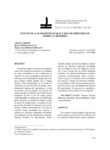Mostrar o rexistro simple do ítem
Efecto de las imágenes raras y del reaprendizaje sobre la memoria
| dc.contributor.author | Campos, Alfredo | |
| dc.contributor.author | Gómez-Juncal, Rocío | |
| dc.contributor.author | Pérez-Fabello, María José | |
| dc.date.accessioned | 2011-07-12T10:57:43Z | |
| dc.date.available | 2011-07-12T10:57:43Z | |
| dc.date.issued | 2008 | |
| dc.identifier.citation | Revista Galego-Portuguesa de Psicoloxía e Educación, 2008, 16: 1691-82. ISSN: 1138-1663 | es_ES |
| dc.identifier.issn | 1138-1663 | |
| dc.identifier.uri | http://hdl.handle.net/2183/7617 | |
| dc.description.abstract | [Resumen] Desde hace siglos se utilizan las imágenes raras como ayuda a la memoria, sin embargo, se sigue estudiando en qué condiciones es efectiva. En esta investigación analizamos la influencia de la estrategia de imagen (sin ima- gen, imagen normal, imagen rara e imagen mixta) y del reaprendizaje en el estudio de oraciones, en tres intervalos de tiempo: inme- diatamente después del aprendizaje, al cabo de un día y de una semana. Un total de 225 sujetos (media de edad de 14.45 años) fueron asignados al azar a uno de cuatro grupos experimentales: un grupo que no utilizó imá- genes mentales, un grupo de imagen normal, un grupo de imagen rara, y un grupo de ima- gen mixta. Se midió el recuerdo, el reconoci- miento, el falso reconocimiento, el acceso a la oración, ítems recordados por oración, y número de oraciones totalmente recordadas. Las imágenes mixtas manifestaron, inmedia- tamente después de aprendizaje, mayor recuerdo, mayor acceso a la oración, y mayor número de oraciones totalmente recordadas que las imágenes raras, las imágenes norma- les, y que el grupo que no utilizó imágenes mentales. Los sujetos manifestaron un mayor recuerdo, reconocimiento, falso reconoci- miento, acceso a la oración, ítems recordados por oración, y número de oraciones totalmen- te recordadas, al cabo de una semana que des- pués de un día, y que inmediatamente después del aprendizaje. Se discuten los resultados y se proponen nuevas líneas de investigación. | es_ES |
| dc.description.abstract | [Abstract] For centuries bizarre imagery has been an aid to memory yet the precise conditions for its optimum effectiveness remain unknown. In this study, the influence of image strategy type (no mental imagery, normal imagery, bizarre imagery or mixed imagery) on the learning of sentences and relearning were evaluated at three time intervals (immediate, at one-day and one-week). A total of 225 sub- jects (mean age 14.45 years) were randomly assigned to one of four experimental groups: a no mental imagery group, a normal imagery group, a bizarre imagery group or a mixed imagery group. Thereafter, recall, recogni- tion, false recognition, sentence access, items per sentence recalled, and number of full sen- tences recalled were assessed. Mixed imagery exhibited, immediately after learning session, greater recall, sentence access, and full sen- tences recalled than the bizarre imagery, nor- mal imagery, and no mental imagery group. Subjects exhibited significantly greater recall, recognition, false recognition, sentence access, items per sentence recalled, and num- ber of full sentences recalled at one week interval than after one day or immediately after first learning session. The results are dis- cussed and further lines of experimental rese- arch are proposed. | es_ES |
| dc.language.iso | spa | es_ES |
| dc.publisher | Universidade da Coruña | es_ES |
| dc.subject | Imagen mental | es_ES |
| dc.subject | Memoria | es_ES |
| dc.subject | Recuerdo | es_ES |
| dc.subject | Reconocimiento | es_ES |
| dc.subject | Falso reconocimiento | es_ES |
| dc.subject | Mental imagery | es_ES |
| dc.subject | Memory | es_ES |
| dc.subject | Recall | es_ES |
| dc.subject | Recognition | es_ES |
| dc.subject | False recognition | es_ES |
| dc.title | Efecto de las imágenes raras y del reaprendizaje sobre la memoria | es_ES |
| dc.type | info:eu-repo/semantics/article | es_ES |
| dc.rights.access | info:eu-repo/semantics/openAccess |






